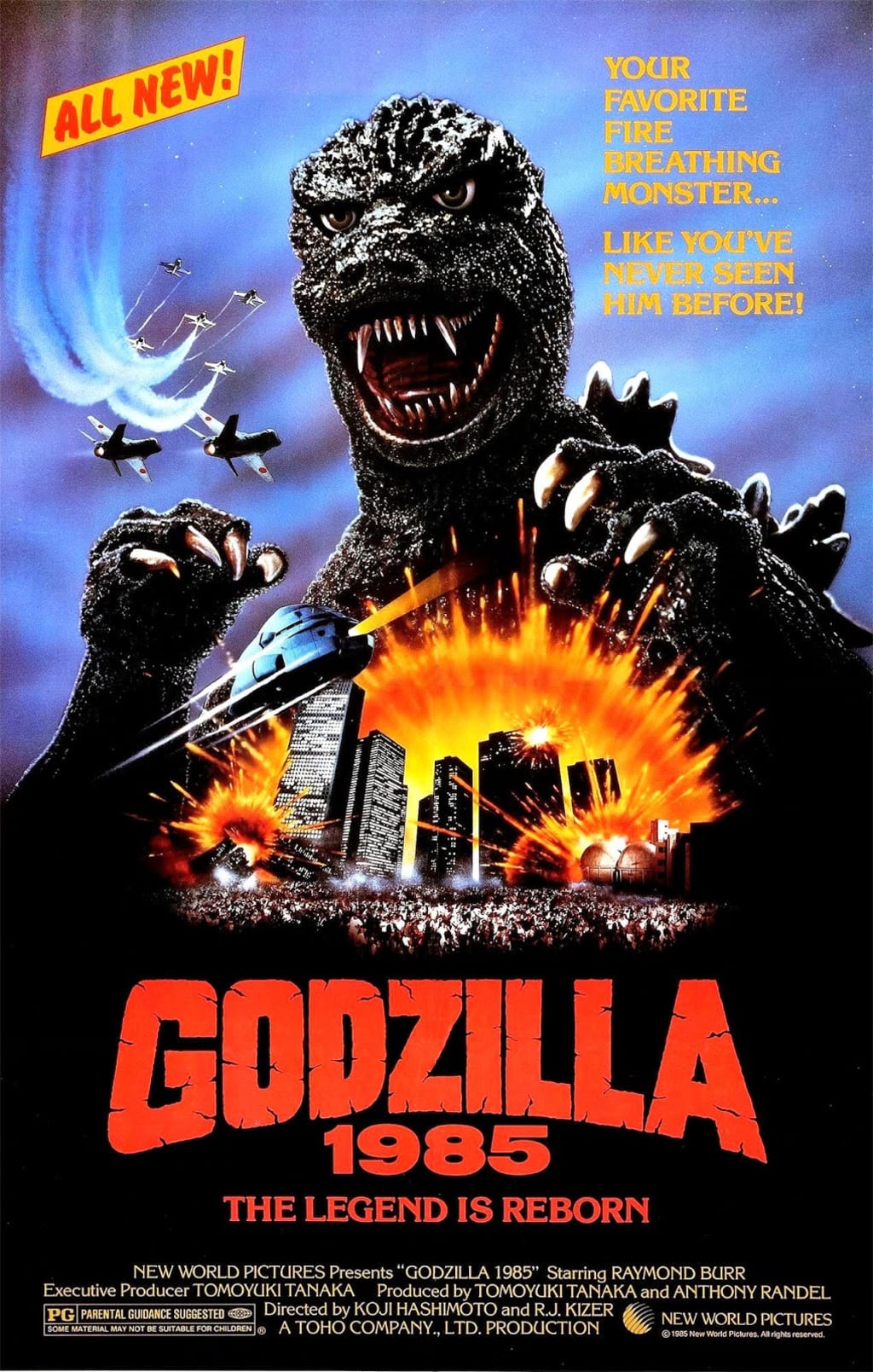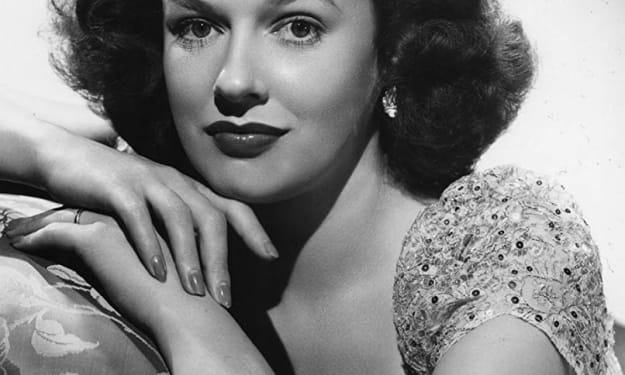
By the 1980s, the Godzilla films had been seen in theatres all over the world, and more importantly, had been seen in television reruns constantly for more than a generation. Some films were good, some were goofy, but they had a lot of fans of all ages. Godzilla had become an icon for Japan. And so, the world's favorite giant monster was brought back, with better plots, better effects, and upgrades across the board.
Godzilla Returns aka Godzilla 1985 (1984)
For the first time, a direct sequel to the original film from 1954 was made, and similar to the original film, this sequel has two cuts and two names. The original film in Japan was "Gojira:, and the 1984 sequel was "Godzilla Returns." In America the original film was "Godzilla King of the Monsters" and the reboot sequel, released in 1985, was "Godzilla 1985." What's more, the American version of the original and the sequel, 30 years later, featured "Perry Mason" actor Raymond Burr portraying American journalist Steve Martin. This was of course funnier in 1985 because by then most of America knew Burr as Perry Mason, and Steve Martin had become a household name due to his enormous success in comedy and films in the 70s and 80s. Fun fact: Burr starred in the first of his 26 made-for-tv "Perry Mason" movies in 1985, after "Godzilla 1985" was released. Perhaps Godzilla was responsible for Burr's revival?
The plot of this film takes the anti-atomic bomb theme of the original a step further, putting Godzilla in the middle of the Cold War between the United States and the Soviet Union. Godzilla as we knew him in 1954 has revived and attacked a ship at sea. Not wanting to alarm the public, the Japanese government keeps it secret, but activates the secret defense force they had formed after the original attack, should the monster ever return.
Over the course of the film, a series of events bring the Americans and Soviets closer and closer to the brink of war. Godzilla's activities are blamed on the Americans and Soviets, and a new, super-powerful bomb is prepared for use. As with the original, the question is made: Is the real threat to humanity something natural like Godzilla, or humanity itself?
Godzilla vs. Biollante (1989)

This film effectively kicks off the second series of Godzilla films in earnest, doing things the previous series never did, namely recurring human characters, character development, and each successive film being linked to the other. In other words, this series was more like the "Star Wars" series, than "Lethal Weapon." Each film built on the others, rather than just having different stories with the same characters.
Following the events of "Godzilla 1985," Godzilla is held on a remote Pacific island, and scientific labs fight for use of samples of his cells taken from his rampage. Those who do have use of his cells have various ideas on how to use them. One such use is to combine them with plant cells, so hardy plants could be grown in difficult terrain, turning deserts into farm fields to feed the world. At the same time, a second use of Godzilla/plant hybrids is conceived, to create a creature to combat Godzilla should he return.
One such plant, combined with a rose, starts out beautiful and innocent, but like Godzilla himself becomes huge and dangerous, and a monster of its own right known as Biollante. This concept seems really lame. I hated the idea and resisted watching the film because it was so ridiculous - Godzilla versus an oversized flower - but it works. Because for the first time since Godzilla fought the Smog Monster, his opponent mutates into more horrid and dangerous forms, reminiscent of John Carpenter's "The Thing" or perhaps "The Blob."
If you were never a fan of the hokey, goofy Godzilla film of the 50s-70s, this is the series for you, and here is the jumping-on point.
Godzilla vs. King Ghidorah (1991)

Of course a new Godzilla series would have to have King Ghidorah. But as with everything else in the new series, Ghidorah got an upgrade, making him even more of a badass.
In the previous film, one of the things used to try to control Godzilla was an anti-nuclear bacteria. While the bacteria didn't kill Godzilla, it did greatly reduce the strength of his breath weapon. You may see the theme here. The original series had Godzilla as the symbol of the dangers of atomic weapons, after the United States destroyed Nagasaki and Hiroshima in World War II with the atomic bomb. 35 years later, new Godzilla is the symbol of the dangers of the nuclear arms race between the United States and the Sovier Union.
In this film, humans from the future appear to try to eliminate Godzilla, who finally destroys Japan in their time. They help create Ghidorah in hopes of wiping out Godzilla while he is weakened. This is a new spin on Ghidorah, who previously had always been a monster from outer space.
Meanwhile, we learn that Godzilla may have actually been seen in the 1940s, as a living dinosaur who helped Japanese soldiers on a Pacific Island. That dinosaur was made into Godzilla as we know him by, of course, atomic testing.
Thus, there are attempts to kill Godzilla the 1940s dinosaur and Godzilla the weakened 1990s monster. But Godzilla gets an upgrade when he encountes a Russian nuclear sub, absorbing its energy and regaining his strength. He soundly defeats King Ghidorah, brutally tearing off Ghidorah's center head. But the future humans aren't done yet. They recover Ghidorah's body and repair his damage with cybernetics, creating a new nightmare: Mecha King Ghidorah!
Godzilla vs. Mothra (1992)

With Godzilla and Ghidorah returning, could Mothra be far behind? In this installment, Mothra gets a new origin, and counterpart, as we learn that eons ago, there were two super-moths, Mothra and Batra. Batra is like a darker version of Mothra, who went out of control and was stopped by Mothra. Now, a giant egg is found, as well as the two tiny women who typically signal the return of Mothra, and it seems both Mothra and Batra will live once more.
Beginning as giant destructive silk-spinning larva, Mothra and Batra eventually morph into their giant moth forms and encounter each other, and Godzilla, who proves to be the true threat to the Earth they were destined to fight. Godzilla had fought Mothra before, but can he possibly win against two of them?
Godzilla vs. Mechagodzilla II (1993)

One of the great things about the rebooted series is, they brought back all the good characters and left out the sillier, less effective ones. In this chapter of the series, we see the return of Rodan, one of Godzilla's greatest allies, and Mechagodzilla, one of his biggest villains.
Again picking up after the previous film, we see the United Nations create a special force to respond to the threat of Godzilla if and when he returns. As part of the plan, they salvage the remains of Mecha King Ghidorah and create Mechagodzilla, as well as a special flying fighter craft with a crew dedicated specifically to fighting Godzilla.
Later, a giant egg is found, emitting a psychic signal that attracts both Godzilla and Rodan, a pterosaur mutated by radiation. The two of them fight over the egg and Rodan retreats. But because Godzilla has appeared, the Godzilla taskforce is brought into action, with Mechagodzilla. Godzilla and Mechagodzilla fight and Godzilla wins, but the humans take away the egg, which later hatches into Baby Godzilla. The baby continues to call out, again attracting Godzilla and Rodan, who join forces to protect the baby, leading to Round 2 against Mechagodzilla. Except this time Mechadozilla has merged with the Godzilla force's fighter craft creating, yes, Super Mechagodzilla.
Godzilla vs. SpaceGodzilla (1994)

So far in the rebooted series, each of the opponents had come from Earth, even King Ghidorah, who previously had been known as a space dragon. With this film, an opponent came from space for the first time, but not from an alien world. Following the defeat of Biollante, which was a plant merged with Godzilla cells, the hybrid cells drifted into the atmosphere and eventually into space, where they were sucked into a black hole and subjected to intense radiation, mutating them further into a new monster - SpaceGodzilla!
Yes, this calls for for significant suspension of disbelief. Ashes or cells of something burned on the surface of the Earth can't just float into space, they would have to be propelled, otherwise they would either float in the atmosphere on wind currents or fall back to Earth. Also, there are no black holes nearby. The nearest one is many light years away. For ashes to be pulled into a black hole that distance from Earth in just the 5 years since the defeat of Biollante, they would have to travel at more than light speed to get there, then mutate into a new life form, then as SpaceGodzilla, travel at greater than light speed to get back. That's a bit more ignorance of physics than I can stomach, though I'm happy to acknowledge that a dinosaur has been mutated by atom bombs and powered up by sucking energy out of a nuclear submarine. Still this stretch of the imagination resulted in SpaceGodzilla, who is quite the formidable new villain, and a nice way to call back to one of the earliest films in the series
Meanwhile, on Earth, the creepy twin fairies normally associated with Mothra warn humanity of SpaceGodzilla approaching, and for the first time, they appear independently of Mothra, which is interesting. Also, the Godzilla task force have put together yet another mecha weapon to fight Godzilla and/or related monster problems. This one is called M.O.G.U.E.R.A., which is a crewed fighting vehicle that splits into a flying fighter and a ground fighter that can tunnel underground. I could cite what M.O.G.U.E.R.A stands for, but it's not very interesting, nor is the vehicle, really, though it is kind of cool to see one of the famously Japanese-style combined mechas, similar to Voltron or Combatra, on the big screen without CGI.
SpaceGodzilla makes it to Earth and encounters both Godzilla and Baby Godzilla, still hanging around after the last movie, and growing. The nice thing about Baby Godzilla in this series is, he looks more like Godzilla. Minilla in the original series was just a bit too claymation/Gumby for me. Way too cute. This version of Godzilla looks more like a small version of the real deal. A bit scary, but still cute and awkward.
Godzilla and SpaceGodzilla fight several times, and M.O.G.U.E.R.A. also gets in the mix, but there is no decisive end. Then, the humans realize SpaceGodzilla is using the giant crystals on his shoulders to tap into the power of the Earth's core, with assistance from a new high-tech building. So a plan is devised to cut SpaceGodzilla off from that power so Godzilla can get the upper hand.
Godzilla vs. Destroyah (1995)

This film has one of the best endings I've seen in a Godzilla film, and is one of the best films overall. It throws back not only to previous films in the series, but to the very first film in 1954. In that one what finally defeated Godzilla was a weapon called The Oxygen Destroyer, which was a kind of depth charge that would wipe out all the oxygen in a body of water and turn the area into a kind of super-acid. When deployed against Godzilla while he was in the sea, it stipped away all his flesh and left nothing but a skeleton, which sank to the bottom of the ocean. In this film, the remnants of that weapon, which effectively are pollution in the ocean, have recombined into a number of creatures, which over the course of the film recombine into a giant creature, Destroyah, which mutates further before the film's end, similar to the Smog Monster from the original series.
When the Destroyah creatures first appear, the Godzilla Task Force go to Infant Island in search of Godzilla, but find both Godzilla and Baby Godzilla (now known as Godzilla Junior) gone, and the island destroyed. When Godzilla does appear, to save Junior, who was fighting Destroyah, his abdomen is glowing red and his breath weapon has noticeably changed. The humans discover that Godzilla was exposed to, and absorbed, the radiation from uranium deposits on Infant Island, and his nuclear heart is now heating up out of control. Similar to the nuclear reactor disaster at Chernobyl, if Godzilla continues to heat up he'll have a meltdown, which could kill every living thing on Earth.
So, the humans use a new mecha weapon to cool Godzilla down while Junior fights Destroyah, directed by a psychic from the Godzilla Task Force who has bonded with him. But Destroyah is too much for Junior, and only the real Godzilla can save the day. However, as he uses his breath weapon, it only worsens the problem with his nuclear heart. Will saving the world from Destroyah ultimately doom it from himself? If you want the secret to the fantastic ending, read the next paragraph. If not, skip ahead to the next film in the series.
*SPOILER*
What happens is the most heart-rending ending in the series. Actual character development in Godzilla. Unlike the original series, where Godzilla softened over time and became a doting father and friend to humanity, in this series Godzilla had a begrudging respect for certain humans and basically kept to his island on a truce until something or someone came to kill him. And Junior, unlike Minilla, is a small Godzilla, he's just not up to the full job yet, and in facing Destroyah, he gets killed. Godzilla is devastated, and unleashes breath fury on Destroyah, seemingly killing it. Mourning Junior, Godzilla is melting down, and exposure to Godzilla's teeming radiation briefly revives Junior, like electric paddles reviving a heart. But he dies again, devastating Godzilla even more. Destroyah revives, once again mutated and more powerful than before after absorbing material from Junior, and Godzilla unleashes a supercharged blast of atomic breath that finally kills the beast. Now at the meltdown level, Godzilla dies, releasing enough radiation to destroy Japan, then the world, except suddenly, the radiation levels plummet and the familiar roar is heard. Godzilla is dead, but Junior has revived and grown to full size. Long live Godzilla!
Godzilla (1998)

Yes, the first American one, otherwise known as "The Matthew Broderick film." Often mocked, I have to tell you, it's not all that bad, and in some ways it's pretty good. Not really good, but worth seeing once or twice.
Essentially TriStar got the rights to do Godzilla, with cooperation from Toho Studios, and the buzz was, TriStar was going to produce a trilogy of films and show the world, and Japan, how a Godzilla film could be done with a bigger budget and better effects. And that kind of happened.
The budget yielded well-known actors like Matthew Broderick and Jean Reno, and CGI was used for the first time, rather than a guy in a suit smashing miniature cities and fighting another guy in a suit. By using CGI, we were also able to see Godzilla do something new, like jump. This version of Godzilla, spawned from an iguana mutated by nuclear testing (by the French, which was an ongoing concern in the 90s), was faster and less bulky than any previous version of Godzilla. Much more like an enormous velociraptor from "Jurassic Park," which was a much newer sensation at the time.
We also saw Godzilla on new grounds - New York City - rather than Tokyo. That was a fresh and welcome change, and seeing New York trashed brought cheers from the audience at the drive-in where I saw it, much like seeing the White House wiped out by aliens brought cheers from the audience when I saw "Independence Day." Outside of New York City and Washington D.C., there was little love for those cities in other parts of the country back then. People were pretty happy to see a giant monster tear up Manhattan right up until Manhattan was really attacked by terrorists in 2001. Then it wasn't funny, and the country rallied around New York, but before that, in 1998, it was screw New York, go go Godzilla!
We also learn that this time Godzilla is definitively a female, because she has laid eggs beneath Madison Square Garden. Yes, no more random dino eggs found here and there. Godzilla is going to be a mom, and if those eggs hatch, New York, if not the world, is screwed.
Those are all good things. There's no monster opponent. No powerful breath weapon, though Godzilla kind of has one. It's different, it's okay, but it's not the Godzilla the world came to know and love. He came back in the next reboot.
About the Creator
Gene Lass
Gene Lass is a professional writer, writing and editing numerous books of non-fiction, poetry, and fiction. Several have been Top 100 Amazon Best Sellers. His short story, “Fence Sitter” was nominated for Best of the Net 2020.






Comments
There are no comments for this story
Be the first to respond and start the conversation.